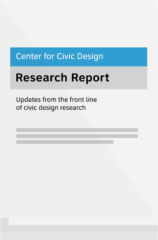Anywhere ballot: Making voting accessible
This research began with a question about addressing a broader range of accessibility issues in voting than the standards in the Voluntary Voting System Guidelines (VVSG) require. The VVSG standards cover accessibility for low vision, blindness, and cognitive disabilities. But what if anyone could mark their ballot anywhere, any time, on any device? While the likelihood of voters voting on their own devices may be remote in the current elections environment, it is likely that election jurisdictions will begin to use consumer off the shelf devices as the voter-facing part of voting systems soon. Thus, we narrowed the scope of our research to prototyping an accessible, responsive, Web standards-compliant front end for ballot marking that would be accessible to voters with low literacy (a previously ignored voter audience) or who had mild cognitive disabilities. The final ballot interface is based on principles of “plain language” and “plain interaction.” The ballot interface is available under a Creative Commons license at anywhereballot.com. The ideas from this research and the larger project it was a part of, Anywhere Ballot, have been used in several voting systems.

Making voting accessible: Designing digital ballot marking for people with low literacy and mild cognitive disabilities
Download the journal article from Journal of Election Technology and Systems (JETS)
Key findings
We came up with 7 design principles based on our research:
- Create a clear, linear flow through the ballot.
- Use language that is simple and easy to understand.
- Make the ballot look easy to read.
- Prompt voters with actions and choices.
- Provide immediate feedback to all actions.
- Make it easy to fix mistakes.
- Support users’ preferences and accessibility needs.
About the research
The Anywhere Ballot started as a research grant for the ITIF Accessible Voting Technology Initiative, funded by the Election Assistance Commission. The lead researchers were Dana Chisnell, Drew Davies, and Kathryn Summers, worked with students at the University of Baltimore Usability Lab. This work focused on prototyping an accessible, responsive, Web standards-compliant front end for ballot marking that would be accessible to voters with low literacy (a previously ignored voter audience) or who had mild cognitive disabilities.
In November 2012 and January 2013, the team conducted rapid iterative testing starting with a paper prototype and then a working digital version. Most of the participants in the testing had a reading, cognitive, or other intellectual disabilities. In these two rounds, the ballot design was iterated, changing the layout from horizontal to vertical, testing different instructions, and refining the visual design, until participants succeeded in marking their ballot. This report, conducted by Kathryn Summers, Noel Alton and Megan McKeever from the University of Baltimore, CCD co-founder Dana Chisnell, and Drew Davies of Oxide Design Co, was based on this research.
The ideas and interactions of the Anywhere Ballot have been used in several voting systems:
- The ClearBallot completed the prototype interface for their ClearAccess ballot marking device
- The Los Angeles County Voting System for All People was introduced for all in-person voting in 2020 with an interface inspired Anywhere Ballot
- An updated interface Anywhere Ballot design was included used for the ElectionGuard reference implementation Ballot Marking Device, shown at the Aspen Security Conference in 2019.
- VotingWorks, which programmed the ElectionGuard interface, adapted it for their own voting system
Related resources
This research was part of a larger project called Anywhere Ballot. Learn more about the project on our website.
- Anywhere Ballot Design Principles (PDF) and accessible text version
- Anywhere Ballot design pattern library (updated April 2015)
- WordPress theme files for the prototype (900Kb zip file)
The Los Angeles County Voting System for All People was introduced for all in-person voting in 2020 with an interface inspired Anywhere Ballot.

